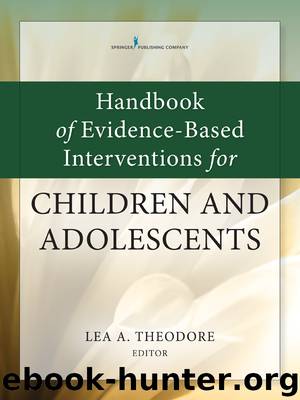Handbook of Evidence-Based Interventions for Children and Adolescents by Theodore Lea A

Author:Theodore, Lea A.
Language: eng
Format: epub
Publisher: Springer Publishing Company, Inc.
Published: 2016-07-06T04:00:00+00:00
Cognitive Behavioral Therapy
Research points to CBT as the most favorable method for effective and appropriate treatment for childhood anxiety (Nauta & Emmelkamp, 2012). Through this psychological treatment approach, youth learn to identify anxious thoughts/cognitions and practice replacing previous maladaptive patterns of behavior with more adaptive ones. Specific attention is given to reduction of both (a) irrational fears associated with separation and (b) avoidant behaviors associated with separation. Fundamental components of CBT include psychoeducation, cognitive restructuring, exposure therapy, relaxation strategies, reduction of avoidance, behavior modeling, social skills training, and homework assignments. CBT can be done individually or within a small group format.
Individual CBT. Individual CBT focuses primarily on treating the child who experiences symptoms of anxiety. Active parental involvement helps one to carry out the treatment program within the home setting. Kendall (1990) was one of the first to develop a manualized CBT program called “Coping Cat” for childhood anxiety disorders. Coping Cat teaches children how to (a) restructure negative or anxious thoughts about separating from an attachment figure and (b) how to use adaptive coping strategies through graded exposure to anticipated or actual situations (e.g., going to school, going to sleep, and being away from parents). Efficacy studies highlight significant gains for participants with separation anxiety disorder, as well as generalized anxiety and social anxiety. For example, remission rates for Coping Cat range from 64% to 77% (Kendall, 1994), with even higher rates reported in long-term follow-up investigations (Kendall, Safford, Flannery-Schroeder, & Webb, 2004).
Walkup and colleagues (2008) demonstrated that the majority of children (60%) benefit from CBT when compared with children randomly assigned to a wait-list control group (23%). Maintenance of treatment gains and further improvements in functioning after only 12 to 16 weeks of CBT have been reported in studies that have followed youth for up to 9 years after treatment (Seligman & Ollendick, 2011). These improvements have been reported for youth presenting with varied comorbid conditions and across different ethnic and cultural groups.
Group CBT. Although potentially less efficacious in clinical settings (Bodden et al., 2008), group CBT may be implemented more frequently in practical settings (e.g., schools and day camps) and is another promising option for the treatment of separation anxiety disorder. Group-based treatment is both time- and cost-effective (Eisen et al., 2011). Considering the prevalence of separation anxiety disorders among school-aged children, this approach may be ideal within a tiered model of service delivery. For example, the FRIENDS (Feelings, Relax, Inner Helpful Thoughts, Explore Solutions, Now Reward Self, Don’t Forget to Practice, Stay Cool!) program (Barrett, Lowry-Webster, & Turner, 2000) not only provides targeted support for groups of children with anxiety, but also incorporates elements of interpersonal therapy, universal preventive care, and parental education. Children and families in the FRIENDS program learn to identify feelings first and to employ relaxation techniques before, during, or after anxiety-provoking situations. Over the course of 10 weekly sessions, they also practice managing their thoughts, problem solving with one another, and giving or receiving rewards for appropriate behaviors. In a randomized controlled
Download
This site does not store any files on its server. We only index and link to content provided by other sites. Please contact the content providers to delete copyright contents if any and email us, we'll remove relevant links or contents immediately.
| Administration & Medicine Economics | Allied Health Professions |
| Basic Sciences | Dentistry |
| History | Medical Informatics |
| Medicine | Nursing |
| Pharmacology | Psychology |
| Research | Veterinary Medicine |
Periodization Training for Sports by Tudor Bompa(7934)
Why We Sleep: Unlocking the Power of Sleep and Dreams by Matthew Walker(6370)
Paper Towns by Green John(4811)
The Immortal Life of Henrietta Lacks by Rebecca Skloot(4269)
The Sports Rules Book by Human Kinetics(4086)
Dynamic Alignment Through Imagery by Eric Franklin(3928)
ACSM's Complete Guide to Fitness & Health by ACSM(3829)
Kaplan MCAT Organic Chemistry Review: Created for MCAT 2015 (Kaplan Test Prep) by Kaplan(3809)
Introduction to Kinesiology by Shirl J. Hoffman(3631)
Livewired by David Eagleman(3540)
The River of Consciousness by Oliver Sacks(3423)
The Death of the Heart by Elizabeth Bowen(3346)
Alchemy and Alchemists by C. J. S. Thompson(3303)
Descartes' Error by Antonio Damasio(3168)
Bad Pharma by Ben Goldacre(3112)
The Emperor of All Maladies: A Biography of Cancer by Siddhartha Mukherjee(2939)
The Gene: An Intimate History by Siddhartha Mukherjee(2933)
The Fate of Rome: Climate, Disease, and the End of an Empire (The Princeton History of the Ancient World) by Kyle Harper(2882)
Kaplan MCAT Behavioral Sciences Review: Created for MCAT 2015 (Kaplan Test Prep) by Kaplan(2824)
